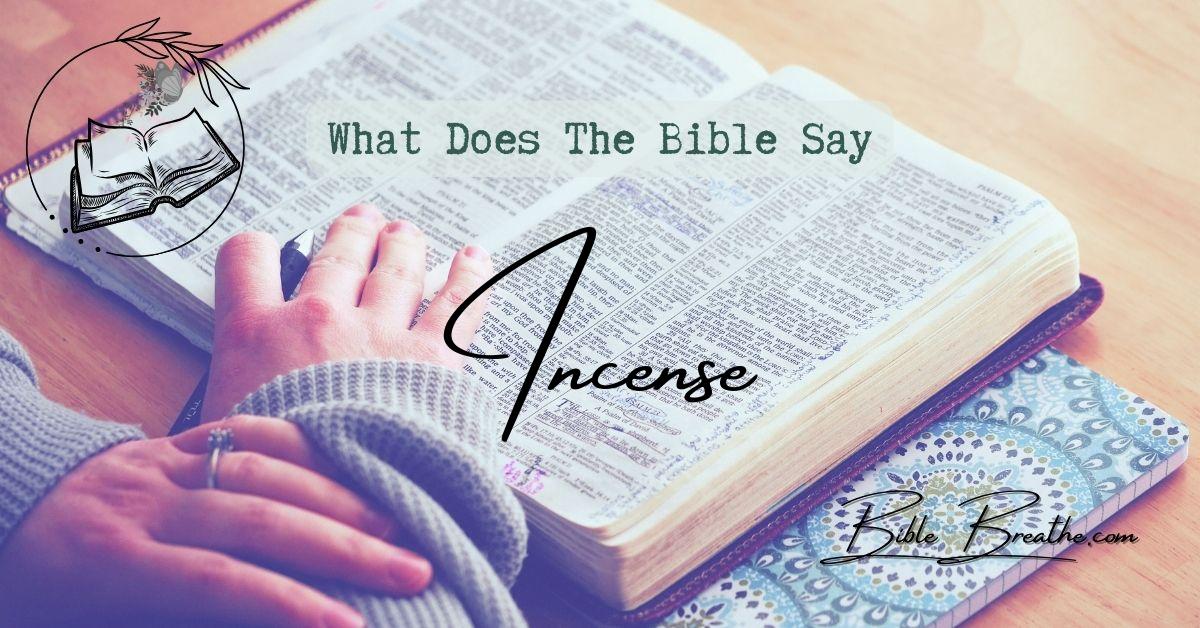Ever wondered what the Bible’s got to say about incense?
Picture it like a sweet scent that’s not just about filling the air with fragrances but filling your soul with meaning.
In the Bible, incense was a big deal, like a secret ingredient in your grandma’s famous dish.
Back in the day, incense was like God’s favorite air freshener in the Old Testament.
It spiced up worship, prayers, and sacrifices.
Think of it as the aroma of faith.
It made the temple holy, like turning an ordinary room into a sacred space.
Now, flip the pages to the New Testament.
Incense turns into a symbol for the prayers of believers.
It’s like God’s inbox, receiving your messages.
So, dive into the Bible with us as we explore this aromatic journey through its pages.
It’s not just about incense; it’s about connecting with the divine in ways you’ve never imagined.
🙏🕊️
Key Takeaways
- Incense in the Bible has a dual nature; it is seen as both sacred and potentially dangerous. While it was used in worship and rituals as a symbol of prayers rising to God, it also represents the danger of offering unauthorized worship, as seen in the story of Nadab and Abihu in Leviticus.
- The deep symbolism of incense in biblical texts is evident throughout both the Old and New Testaments. It often represents the prayers and praises of God’s people, as mentioned in Psalms and Revelation. Additionally, incense is associated with purification and consecration, signifying a holy and set-apart aspect of worship.
- Interpreting biblical references to incense requires careful consideration of the context. Different passages may emphasize different aspects of incense, such as its use in the tabernacle or temple, its role in worship, or its symbolic significance. Understanding the cultural and historical context is crucial for a comprehensive interpretation.
- The use of incense in worship has evolved over time within various Christian traditions, with some continuing to incorporate it into liturgical practices and others not. This diversity reflects the broader range of interpretations and practices surrounding incense in the context of modern Christianity.
- Exploring what the Bible says about incense invites believers to delve into its rich symbolism and historical significance, providing a deeper understanding of its role in worship and spiritual life.
The Heavenly Aroma: Unveiling the Bible’s Take on Incense
Photo modified by BibleBreathe.com. Original photo by Karolina Grabowska on Pexels
Ever wondered about the aromatic tales the Bible shares about incense?
It’s like this beautiful fragrance woven into the fabric of the Old and New Testaments, leaving a sweet-scented mark.
Let’s uncover what the Bible says about incense.
God’s Special Request for Incense
When God had a heart-to-heart with Moses on Mount Sinai, it was more than just about the Ten Commandments.
Among the divine words, there was a specific instruction about incense.
God guided Moses and Aaron on crafting a unique incense, to be set ablaze on the golden altar of incense within the tabernacle.
“And the Lord said unto Moses, Take unto thee sweet spices, stacte, and onycha, and galbanum; these sweet spices with pure frankincense: of each shall there be a like weight: And thou shalt make it a perfume, a confection after the art of the apothecary, tempered together, pure and holy.” – Exodus 30:34-35 (KJV)
This sacred blend of fragrances was to be ignited daily, filling the tabernacle with an aroma that pleased—a symbol of worship and prayers rising to heaven.
It was like the prayers of God’s people ascending to Him, just as the smoke lifted from the censer.
The Precise Fragrances in the Temple’s Incense
The recipe for this holy incense was meticulous, featuring stacte, onycha, galbanum, and pure frankincense.
Each ingredient held profound significance.
Stacte, a resin, symbolized purity and divine consecration.
Onycha, an aromatic secretion from shellfish, signified the intercession of prayer.
Galbanum, an aromatic resin, represented humility, as it was harvested through a humble cutting of the plant.
Lastly, frankincense, the most renowned, symbolized righteousness and mediation.
Mixing these fragrances birthed a potent aroma that engulfed the temple, serving as a reminder of God’s presence to the worshipers.
“Let my prayer be set forth before thee as incense; and the lifting up of my hands as the evening sacrifice.” – Psalm 141:2 (KJV)
In today’s terms, think of incense as the fragrant bridge between the earthly and the divine.
Just like a pleasant scent can lift our spirits and create a peaceful atmosphere at home, the temple’s incense was a tangible reminder of God’s presence and the importance of prayer and worship.
As we journey through the Bible’s take on incense, we realize it’s not just about lovely smells; it’s about the spiritual link it embodies—a connection between our hearts and the divine.
So, when you catch a whiff of incense, remember the deep biblical roots, urging us to offer our prayers and worship with hearts as pure as the fragrances once graced the tabernacle.
🌿
The Aroma of Prayer: A Deeper Look into Biblical Incense
Photo modified by BibleBreathe.com. Original photo by Aslak Sønderland on Pexels
Ever caught a whiff of incense and wondered, “What’s the big deal in the Bible?”
Let’s break it down, real simple.
Incense: More than Just a Sweet Smell
“Let my prayer be set forth before thee as incense; and the lifting up of my hands as the evening sacrifice.” – Psalm 141:2 (KJV)
In the Bible, incense isn’t just about creating a nice scent.
It’s like prayer made tangible.
Picture this: just as the fragrant smoke rises, so do our prayers, wafting up to God.
It’s like saying, “Hey God, catch this prayer.”
It’s a beautiful picture of pouring out our hearts with devotion and respect.
Where Altar Meets Worship
Incense and the altar are like peanut butter and jelly—they go hand in hand.
Back in the day, it was burned on the altar as an offering to God.
Think of it as a symbol of worship and love.
When we pray, it’s like bringing our hearts to God’s altar.
The sweet smell of incense reminds us how important worship is.
Prayers and Perfume: A Spiritual Blend
“And the smoke of the incense, which came with the prayers of the saints, ascended up before God out of the angel’s hand.” – Revelation 8:4 (KJV)
Incense isn’t just random smoke; it’s tied to sacrifice and love for God.
When we pray sincerely, it’s like sending up a fragrant gift to the Lord.
It’s a nudge to keep our prayers pure and true, just like the incense.
Temples and Fragrant Whiffs
Picture the grand temple with incense filling the air, making it feel holy and special.
That scent?
It’s a symbol of God being right there with His people.
Our hearts, filled with prayer, become like that temple—home to the Holy Spirit.
Final Thoughts
So, next time the sweet aroma of incense tickles your nose, remember it’s more than a pleasant smell.
It’s a reminder of the power and beauty of prayer in your spiritual journey.
It’s like a fragrant prayer reaching up to the heavens.
Shedding Light on Biblical Insights about Incense
Photo modified by BibleBreathe.com. Original photo by Philippe Donn on Pexels
Ever dug into the Bible and discovered how it unveils the secrets of incense on our spiritual journey?
It’s like finding treasures in a hidden chest.
Let’s uncover some crucial passages and dig into their deeper meanings.
Psalm 141:2 – A Prayer’s Fragrance
“Picture this: Let my prayer rise like the sweet scent of incense, reaching God’s throne. As I lift my hands in prayer, it’s like presenting an evening sacrifice.” – Psalm 141:2 (KJV)
King David, in his poetic style, paints a vivid image of prayer ascending to God like the fragrance of burning incense.
Just as the aroma wafts upwards, our prayers are a sweet scent to the Almighty.
David’s words remind us that our prayers aren’t mere words; they’re a fragrant offering that reaches God’s very throne.
Each prayer is like a musical note in a sweet-smelling symphony of devotion.
Revelation 5:8 – Incense in Golden Bowls
“Now imagine this: When the Lamb received the book, celestial beings and elders fell down in worship. They held harps and golden vials filled with heavenly scents—the prayers of the saints.” – Revelation 5:8 (KJV)
In John’s apocalyptic vision, we witness a celestial scene of worship.
Elders hold golden vials filled with scents, symbolizing the prayers of the saints.
This imagery reminds us that our prayers aren’t forgotten; they’re stored in heavenly vessels.
When the elders offer these vials before the Lamb, it signifies the importance and acceptance of our prayers in the divine realm.
It’s like our prayers are stored in heaven’s treasure chests, waiting to be poured out in God’s perfect timing.
Luke 1:10 – A Heavenly Encounter
“Picture a grand cathedral filled with the fragrance of incense. The whole assembly prayed as incense burned. It was in this sacred moment that an angelic visitation occurred.” – Luke 1:10 (KJV)
In Luke’s Gospel, we witness an extraordinary moment in the temple.
Zechariah, the priest, burns incense at the altar, and a celestial messenger appears to announce the birth of John the Baptist.
This event highlights the sacredness of incense in worship and the profound connection between prayer and divine intervention.
Imagine the scene: The air is filled with the sweet scent of incense as prayers ascend.
In this sacred moment, a heavenly messenger delivers a divine message.
It’s a reminder that in our worship and prayer, when the fragrance of devotion rises, God’s presence can manifest in unexpected and awe-inspiring ways.
These verses, like dazzling gems in a spiritual crown, remind us of the deep significance of incense in the Bible.
It’s not just about the pleasant aroma; it’s about the spiritual connection it symbolizes.
So, when you light incense during your moments of prayer and worship, remember that your prayers, like rising incense, are a fragrant offering before the Creator—a connection to the divine, a testament to faith’s power.
🌟
Handle with Care: Navigating Biblical Caution on Incense
Photo modified by BibleBreathe.com. Original photo by Pixabay on Pexels
Ever wondered why the Bible talks about incense with a caution sign?
Let’s take a journey into this and unravel the cautionary tales it holds.
Incense: Sweet Aroma, Serious Business
And Nadab and Abihu, the sons of Aaron, took either of them his censer, and put fire therein, and put incense thereon, and offered strange fire before the Lord, which he commanded them not.” – Leviticus 10:1 (KJV)
Let’s rewind to Aaron’s sons, Nadab and Abihu.
Picture this: they got a bit fancy with their incense offering, not following the divine recipe.
Result?
Divine displeasure.
It’s a neon sign saying, “Follow the recipe, folks!”
The Heat of Missteps
Ever heard of Korah, Dathan, and Abiram?
They took the incense game too far, way off the divine playbook.
“And it came to pass, as he had made an end of speaking all these words, that the ground clave asunder that was under them: And the earth opened her mouth, and swallowed them up, and their houses, and all the men that appertained unto Korah, and all their goods.” – Numbers 16:31-32 (KJV)
Imagine the earth having a say in the incense fiasco!
The rebels got swallowed up, houses and all.
Lesson learned: Play by God’s rules.
Obedience: The Golden Rule
What’s the big takeaway here?
Obedience, my friends.
Obedience is key, even with incense.
These stories aren’t just tales; they’re warnings.
Incense, though a beautiful symbol of prayer, isn’t to be messed with.
It’s about respect and following the divine guidebook.
Our worship, including the use of incense, should be a symphony of obedience, honoring God in every note.
So, next time you light that incense, remember—it’s not just about the aroma; it’s about obedience.
Play it right, and let your prayers rise like the sweetest melody.
🎶
Aroma of Revelation: Incense Unveiled in the New Testament
Photo modified by BibleBreathe.com. Original photo by cottonbro studio on Pexels
While the Old Testament lays a rich tapestry of teachings on incense, the New Testament beautifully continues this thread, infusing the symbolism of incense into the fabric of Christian faith.
Let’s embark on a journey to unravel how incense is portrayed in the New Testament and the profound meanings it carries.
The Birth of Jesus: Frankincense and Myrrh
In the Gospel of Matthew, we encounter the Magi, wise men who brought gifts to the infant Jesus.
Among these precious offerings were frankincense and myrrh.
“Now, picture this: They entered the house, and there before them was the young child with Mary, his mother. They fell down and worshipped him. Opening their treasures, they presented gifts—gold, frankincense, and myrrh.” – Matthew 2:11 (KJV)
Frankincense and myrrh were no ordinary gifts; they carried profound spiritual symbolism.
Frankincense represented Jesus’ divinity and his priestly role.
Just as incense was used in the Old Testament to symbolize prayer and worship, it foreshadowed Jesus’ ministry as the ultimate mediator between God and humanity.
Revelation: The Golden Censer
In the book of Revelation, we step into a realm of vivid imagery portraying heavenly worship, including the use of incense.
In Revelation 8:3-4, an angel stands before the throne of God with a golden censer, offering incense along with the prayers of all saints.
“Now, envision this: Another angel approached the altar, holding a golden censer. He was given much incense to offer, mingled with the prayers of all the saints on the golden altar before the throne.” – Revelation 8:3 (KJV)
This scene beautifully illustrates the continuity of the incense tradition from the Old Testament to the New.
The prayers of the saints, symbolized by the incense, ascend before God, underscoring the ongoing importance of prayer and worship in the Christian faith.
Our Prayers as Incense
In the New Testament, we find a clear link between our prayers and incense.
The Apostle Paul, in his letter to the Philippians, uses the imagery of incense to describe the prayers of believers.
“Here’s a thought: I have all I need and more, thanks to the gifts you sent with Epaphroditus. They are a sweet-smelling sacrifice that is acceptable and pleasing to God.” – Philippians 4:18 (KJV)
Paul’s words serve as a reminder that just as incense was a fragrant offering in the Old Testament, our prayers are a pleasing aroma to God in the New Testament.
When we pray, it’s as if we are offering incense, symbolizing our devotion and connection to the divine.
In contemporary terms, think of incense in the New Testament as a bridge that connects the Old and New Covenants.
It represents the continuity of faith, prayer, and worship from ancient times to the present day.
As we navigate the essence of incense in the New Testament, we discover that it’s not a mere relic of history; it’s a symbol of enduring faith and devotion.
So, when you encounter incense in your Christian journey, remember its profound meanings in both the birth of Christ and the ongoing worship of believers, connecting us to the divine in a fragrant tapestry of faith.
🌿
Frequently Asked Questions (FAQs) About What Does The Bible Say About Incense
Why is incense considered an abomination in some contexts?
In certain contexts, incense can be considered an abomination when it’s used in idolatry or false worship.
The Bible warns against using incense for other gods, emphasizing that genuine worship should be directed towards the one true God.
How was incense used in the temple?
Incense was used in the temple for worship and purification.
It symbolized prayers ascending to God and the sweet aroma of worship.
It played a significant role in the temple’s rituals.
What are the specific fragrances mentioned in the Bible?
The Bible references various fragrances, including frankincense, myrrh, cinnamon, and more.
These scents were used in religious rituals, symbolizing offerings, and as components in anointing oils.
They carried spiritual significance, representing purity, prayer, and reverence.






